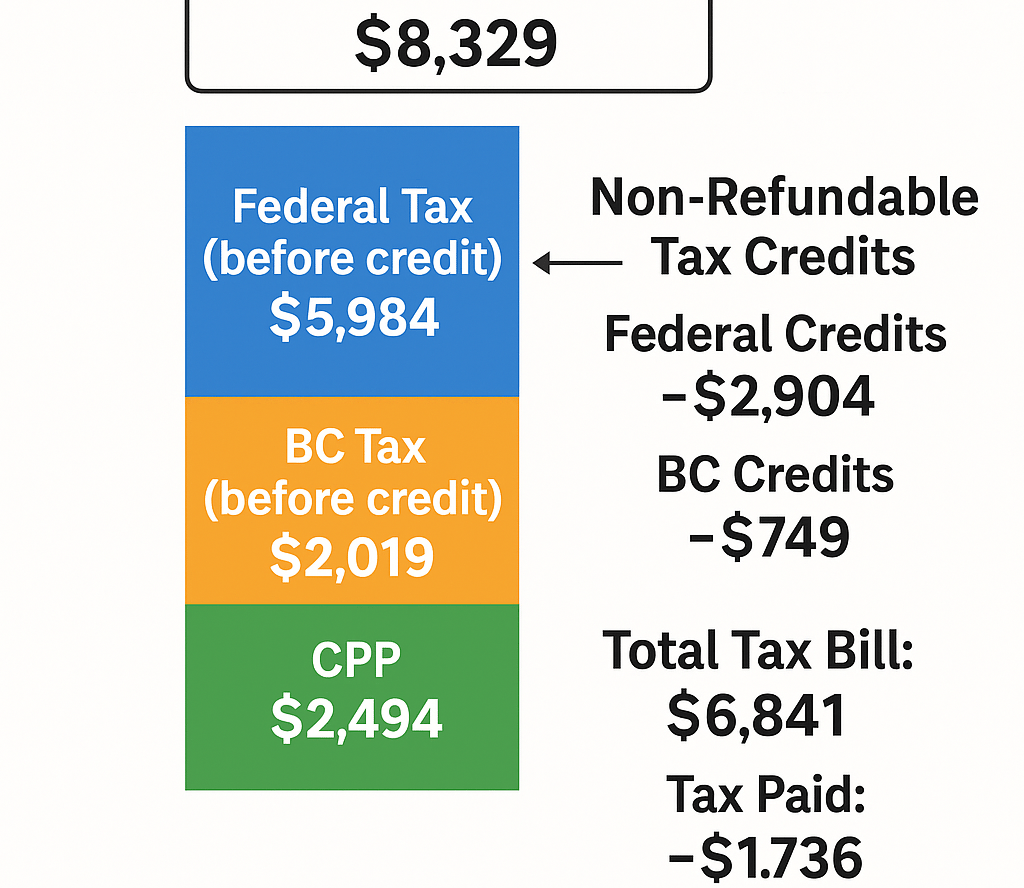new clients - Students/seniors $35 - Corp tax filing starts $800 - install app
Why You Owe Taxes: A Simple Guide to Taxable Income, Credits, and Deductions
Confused about why you owe taxes even with a job? This post breaks down taxable income, deductions, non-refundable tax credits, CPP, and what self-employed Canadians need to know. Learn how to avoid surprises and plan better for next year’s tax bill.
4/23/20252 min read


Here's a blog article that clearly explains everything using your real-life example. It's designed for any taxpayer—especially self-employed—to understand the full picture of how tax works in Canada.
💰 Understanding Your Tax Bill in Simple Terms: A Guide for Canadians (Self-Employed & Employed)
If you're like many Canadians, especially those running a small business or freelancing, tax season can feel like a confusing mess of numbers and CRA letters. You file your return, and boom—you find out you owe thousands. Why? What happened? Let's break it all down, in a way that actually makes sense.
🧾 1. What is Taxable Income?
Your taxable income is what the government uses to calculate how much income tax you owe. It’s your total income minus certain deductions.
Example:
Total income: $48,221
Includes:
Employment: $19,797
Business income (self-employed): $21,920
Interest and EI benefits
Minus deductions (like RRSP and CPP): $8,329
👉 Taxable income = $39,892
💡 2. What Are Deductions?
Deductions reduce your taxable income, not your tax directly. These include:
RRSP contributions
CPP payments (if self-employed)
Childcare expenses
Union/professional dues
Think of deductions as ways to "shrink the number" CRA uses to calculate your tax.
🎁 3. What Are Tax Credits?
Unlike deductions, credits directly reduce your tax bill. But most are non-refundable, meaning:
They can bring your tax down to zero
But won’t give you money back if your tax is already low
Some key credits:
Federal Basic Personal Amount (BPA): $15,705
BC Basic Credit: $12,580
CPP/EI contributions
Canada Employment Amount
Medical/tuition/donation credits
📉 4. How Is Tax Calculated?
Here’s a breakdown using a real scenario:
Type Amount Federal tax (15%) $5,984 BC tax (5.06%) $2,019 CPP (self-employed) $2,494 ➖ Federal credits -$2,904 ➖ BC credits -$749 ✅ Total tax bill $6,841
The person only paid $1,736 in tax during the year (from a regular job), so they owe CRA $5,105!
🧠 5. Why You Might Owe Tax (Even if You're Employed)
If you're self-employed, no one is deducting tax for you. Even if you also have a part-time job with tax withheld, it usually isn't enough to cover everything.
Also, as a self-employed person, you're responsible for both parts of CPP—what would normally be split with an employer.
❌ 6. Is Any Income Tax-Free?
Yes—but only up to a point:
Basic personal amount (federally): $15,705 is tax-free
BC amount: $12,580 is also tax-free provincially
Other credits might apply, but only to reduce your tax, not the income itself
So if you make very low income (under $15,000), you likely owe little or nothing. But once you cross into higher brackets or earn self-employed income, tax kicks in fast.
🛠 7. Recommendations for Self-Employed Business Owners
To avoid big tax bills and surprises:
✅ 1. Set money aside year-round
Save 25–30% of your net income (after expenses) in a separate account.
✅ 2. Make quarterly tax payments to CRA
These are called installments and help spread the tax out through the year.
✅ 3. Contribute to your RRSP
It directly reduces your taxable income.
✅ 4. Track your expenses
Use apps or software to track business expenses—you’ll save on taxes if you deduct them properly.
✅ 5. Work with a tax pro or accountant
Especially if your situation includes self-employment, rental income, or investments.
📬 Final Thoughts
Owing tax doesn’t mean you did something wrong—it just means you made money and need to catch up with CRA. Understanding the difference between income, deductions, credits, and how much tax was already paid is the first step to staying ahead.
Want help setting up a tax-saving strategy or calculating installments? Let’s chat! 😊
Services
Personalized tax preparation and consulting for all.
Location:
Support
email: info@tikitax.com
Phone:(+1).236.788.7799
© 2024. All rights reserved.
2339 HW 97, Kelowna, BC, Canada
145 Chadwick Ct Suite 220, North Vancouver, BC V7M 3K1
